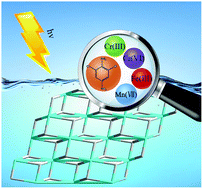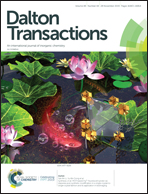A water-stable zinc(ii)–organic framework as a multiresponsive luminescent sensor for toxic heavy metal cations, oxyanions and organochlorine pesticides in aqueous solution†
Abstract
A novel metal–organic framework with the formula [Zn3(DDB)(DPE)]·H2O (1) (H5DDB = 3,5-di(2′,4′-dicarboxylphenyl)benzoic acid and DPE = 1,2-di(4-pyridyl)ethylene) has been solvothermally synthesized by employing a rigid carboxylate ligand H5DDB to assemble with Zn(II) ions in the presence of a flexible bis(pyridyl) linker DPE. The Zn-MOF is a 3D framework with six-nuclear clusters and possesses remarkable water stability and pH stability. Interestingly, complex 1 can sensitively and selectively sense Fe(III), Cr(III), Cr(VI), Mn(VII) and the pesticide 2,6-Dich-4-NA with low detection limits in aqueous solution. Moreover, complex 1 also exhibits selectivity for 2,6-Dich-4-NA detection in real samples including carrot, grape and nectarine extracts, and its detection ability is almost unchanged in the presence of the surfactant sodium dodecyl sulfate (SDS). The possible mechanisms of luminescence quenching have been explained by the weak affinity of nitrogen atoms, resonance energy transfer, and photoinduced electron transfer. To our knowledge, this is the first example of a MOF-based multiresponsive fluorescent probe for the simultaneous detection of Fe(III), Cr(III/VI), Mn(VII) and the pesticide 2,6-Dich-4-NA in aqueous solution.



 Please wait while we load your content...
Please wait while we load your content...